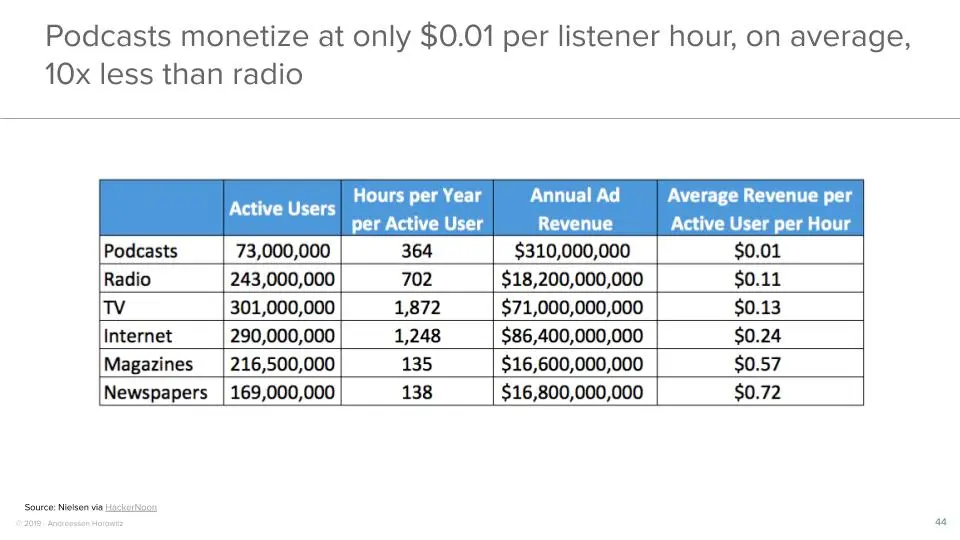The podcast economy is broken. To understand how broken it is, take a look at this chart prepared by Silicon Valley VC firm a16z*:
Why do podcasts monetize so poorly?
The answer to that question has to do with our assumption about what a podcast is, or more accurately, what it is most like.
People predominantly assume podcasts are like radio. Look again at the chart above. Do you see the assumption? Here it is: “podcasts monetize… 10x less than radio.”
Why is radio the comparison? Why not “internet?” After all, podcasts are a technology of the internet, not of radio. They are distributed via the internet, not via AM/FM radio frequencies.
If we shift our comparison from “radio” to “internet,” the brokenness of the podcast economy becomes more profound: podcasts monetize 20x less than the internet. Holy crap!
Once we recognize that podcasts should be compared to other internet technologies and not to radio we can ask better questions to identify the root problem causing podcasting’s poor monetization. Once you know the problem, you know the solution.
Here are three questions we should start with:
What are the core mechanisms of the internet economy?
How do content creators make money on the internet?
What drives consumer engagement with internet content?
At a high level, the answer to all three questions is the same: interactivity.
What are the core mechanisms of the internet economy? Hyperlinks, comments, and other mechanisms empowering consumers to interact and communicate with internet content (and internet content creators). Critically, these interactions generate analytics that offer advertisers and content creators unprecedented insight and validation.
How do content creators make money on the internet? By people interacting with online content using hyperlinks in various forms (clickable links, buttons, etc). Some of these interactions lead to direct monetization (ex: one-click buying on Amazon), some to indirect monetization (ex: Amazon Associates links), and some to no monetization whatsoever.
What drives consumer engagement with internet content? The ability to interact with it through likes, link sharing, comments, and more.
What’s the internet without interactive mechanisms? Broadcast.
Economically speaking, the seismic shift the internet brought to broadcast was certainty. The world of broadcast ratings are, fundamentally, sophisticated guesswork. The world of internet analytics aren’t guesswork. Why? Interactivity. People interact with internet content and every interaction is measurable, therefore we know what content is attracting interest, driving engagement, and ultimately converting to sales.
The tools of interactivity are available to every technology of the internet: blogs, websites, videos, social media stories and posts. There’s one glaring exception: podcasts.
“Podcast analytics are a black box.”
If podcasts lack the core mechanisms of the internet economy, is it any wonder they monetize 20x less?
This lack of interactivity is a felt problem among podcast creators and listeners alike. Consider, for example, this exchange which took place between a16z General Partner Connie Chan and Editor in Chief, Sonal Chokshi:
Connie: I guess what I’m saying — like, rather than rely on Google as the search engine to do it, at least very basic transcription and search, all the platforms should be able to do it themselves. And like, imagine all the other stuff you’d like to tack onto it. Like, hey, maybe in addition to the podcast on podcasts today, you have, like, five links that the listener can go in and click on…
Sonal: Click while you’re playing.
Connie: Yeah.
Sonal: I would love the ability to embed a link natively, instead of in the show notes.
Connie: Or a PDF that you can then charge more money for.
Sonal: Right.
Connie: Like, hey, to read more.
Sonal: Right, right.
Connie: Or maybe, like, all the, like, parts that you cut out.
Sonal: Yeah, yeah.
Connie: Like those special clips, maybe someone pays, like, a dollar to un-tap it, right?”
Where does Sonal’s idea of embedding a link natively come from? It comes from her experience using every other product of the internet.
Why does this problem exist?
Several reasons. Here are four of them:
RSS is a legacy distribution technology that had its advantages but is now deprecated and ill-suited to the task of making shows interactive.
Apple Podcasts dominates the consumption space but Apple has done little to open up that massive consumption platform to innovation.
The ecosystem is fractured and largely non-integrative with other industry technology.
People think of podcasts as being like radio instead of like another web property (see above), radio isn’t interactive, so the lack of interactivity might be frustrating but it doesn’t present like an obvious solution to a huge problem.
These reasons do not mean the problem cannot be solved, but it will take focused work and a clear-eyed vision for how interactivity will unlock the latent potential of the podcast economy.
Once listeners can interact with podcasts the same way they interact with other internet content, podcasts will enjoy the same (likely better) per listener hour revenue as other platforms on the internet. This is because creators and advertisers will have access to important analytics and will be able to drive engagement that (in my estimation) will far surpass engagement on most other platforms, including many social media platforms. Interactivity will amplify the success of every monetization effort currently at-play for podcasts: ads, donations/patronage, promo code/affiliate partnerships, and premium subscriptions. It’ll also create opportunities for new forms of monetization. More on that later.
TL;DR: The podcast economy is broken because podcasts aren’t interactive.
* This chart was embedded in a “market map” of the Podcast ecosystem prepared in 2019 by a16z. Even though it is almost three years old, the “map” thoroughly and concisely addresses the present strengths, weaknesses, and opportunities in the podcast ecosystem at the start of 2022, so I’ll use it as a jumping off point for my commentary and analysis.

